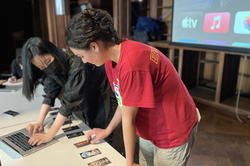A fall Digital + Media studio focuses on art and artists who intentionally deploy camouflage and invisibility in their chosen disciplines.
Interdisciplinary Sculptor and RISD Alum Brian Oakes Sees Tech as Vital Artistic Medium

When interdisciplinary sculptor Brian Oakes 18 SC was a student at RISD, they happened upon a huge pile of “techno-waste”—cables, dongles, monitors, speakers—that inspired a fresh take on materiality and moved the artist’s practice in a new direction. A member of the first cohort of Computation, Technology and Culture (CTC) concentrators, Oakes was already making mechanized work meditating on humans’ relationship with technology and “blurring the boundaries between device, art and the divine,” and they began focusing on electronic hardware as a compelling new medium.
“The CTC concentration was so open-ended and inspiring,” Oakes recalls. “It was great to be part of such a focused community and to work closely with brilliant artist/educators like Kai Franz and Clement Valla MFA 09 DM.”
In November, Oakes offered a talk on campus and visited Ambient Interfaces: Activated Objects—a Digital + Media/CTC concentration class taught by Tess Oldfield MFA 23 DM—just as RISD prepares to launch Computation, Technology and Culture as a new academic department. Encompassing two majors—Art and Computation and Sound—it’s the first new undergraduate department to be introduced since 1996, when the Furniture Design department was launched.


“The new CTC department will allow students to use coding, software and other technological interfaces as creative mediums in their own right,” Valla explains. “We’re excited to see what happens when technology prioritizes aesthetics, human experience, ethics and poetics.”
Oakes used similar language to describe their favorite artists, from the late Paul Thek to free-form electronics artist Kelly Heaton and seminal sound artist Onyx Ashanti. “Technology is an artistic medium and should be treated as such,” Oakes told the large crowd of students who came to their talk. “We need to stop pandering to the typical gallery’s white cube treatment and prove that this new medium is legitimate.”
Based in Brooklyn, the unconventional maker has been showing work in unexpected venues, like Dunkunsthalle, a former NYC Dunkin Donuts shop turned gallery, and an abandoned public school in Brooklyn. They describe their creative process as “extremely meditative” and the labor of craft as “a form of communion.”
Early projects were activated by Arduino circuit boards using motion, sound and light. In recent years, Oakes has transitioned to designing Professional Circuit Boards (PCBs), which are scalable and more reliable than their predecessors.
“I’m attempting to reject the existing supply chain, blow up established systems and make meaning in this sometimes debilitating age of tech.”

But they’ve also been quietly experimenting with DIY materiality inspired by artists like Harris Rosenblum, who makes everything “from scratch.” They’re stepping away from the PCBs and other technocraft the art world is beginning to recognize them for and taking chances with new ideas and techniques.
In the words of the gallerists at Blade Study in NYC, where Oakes had a solo exhibition earlier this fall, “the artist is inserting themself into industrial processes inherited from previous generations of production, exploiting established systems to produce works with the veneer of function that address the process of refinement.”
“I’m attempting to reject the existing supply chain, blow up established systems and make meaning in this sometimes debilitating age of tech,” Oakes adds. “I’m also learning to trust my gut.”
Does Oakes still gravitate to techno-waste? one student asked. “Definitely,” they responded. “I’m constantly using and reusing electronic components and hoard everything I can find.”
Vessel 4 (see top photo) is on view at R & Company in NYC through January 10, 2025.
Simone Solondz / photos by Kaylee Pugliese
November 25, 2024


